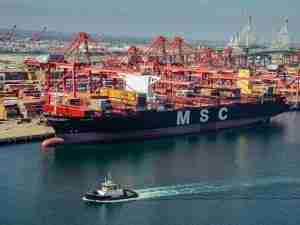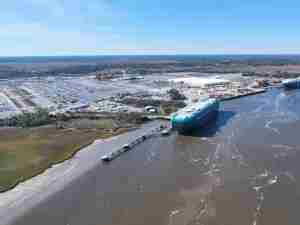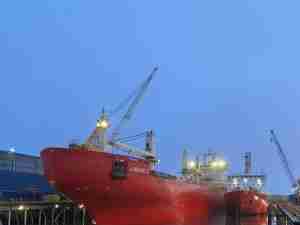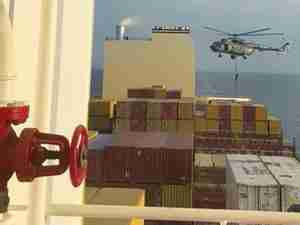
The Yangtze River (also called Changjiang) is the longest river in China and is the third-longest river on Earth behind the Nile and Amazon. It divides China into north and south, and flows through a total of 22 Chinese large cities. Two of these, Shanghai and Jiangsu, are now being connected to each other through the construction of a bridge which will span the Yangtze estuary to the East China Sea. The concrete and steel bridge construction will eventually form part of the Shanghai motorway and has been designed to shorten the current 52 km long route between Shanghai and Qidong by 7 km. The 330 million euro bridge will feature 6 lanes - 3 on each side.
The load-bearing structure of the bridge consists of 12 prefabricated segments manufactured by the "Jiangsu Zhongtai Steel Structure Co. Ltd. (ZTSS)" in Jiangsu. The challenge was to transport the gigantic steel constructions from the production facility to the jobsite - a distance of around 2 km. The dimensions of the individual segments speak for themselves: 2 segments each weighing 595 t and 56 m long, 2 segments weighing 1,890 t and 147 m long respectively as well as 8 segments each with a weight of 2,566 t and 185 m long. For transporting the total of 25,500 t of steel, self-propelled heavy duty vehicles from the French vehicle manufacturer, NICOLAS Industrie SAS, were used. The Chinese enterprise, ZTTS, is a long-standing customer of the French transport vehicle producer and uses its transportation equipment in its daily manufacturing operations. The 12 bridge segments were moved in each case on NICOLAS MDE SP and MDED SP (SP = self-propelled) axle lines. Both vehicle types have been designed to handle challenging operations on the roads as well as special requirements regarding the transportation of plant equipment and large components in the industrial sector. The modular construction allows a wide range of coupling possibilities of the individual vehicle units both longitudinally and crosswise. The individual bridge elements roll towards the Yangtze estuary on a total of 112 axle lines. In the process, the 48 axle lines at the front and 64 lines at the rear were arranged in a 4-file formation, i.e. 2 x 24 and 2 x 32 axle lines respectively coupled laterally. Both transportation combinations are connected to each other by means of a data cable and driven by 4 Power Packs. The total combination is steered using only one remote control.
On arrival at the river bank, the load is rolled on to a pontoon. Here, the hydraulic axle compensation of the self-propelled platform trailer is really pushed to the limits of its capabilities when driving over the ramps. The NICOLAS pendulum axle technology has a lifting height of 650 mm which is necessary particularly in the case of the transporting extra large loads in order to ensure that the permissible axle load is not exceeded as well as to protect the vehicles against overloading. The transport is taken by pontoon to the assembly point in the estuary between Chongming Island and Jiangsu where the individual bridge segments are mounted to each other with the help of a ship crane. The bridge is scheduled for completion in June 2012.











